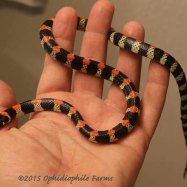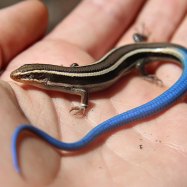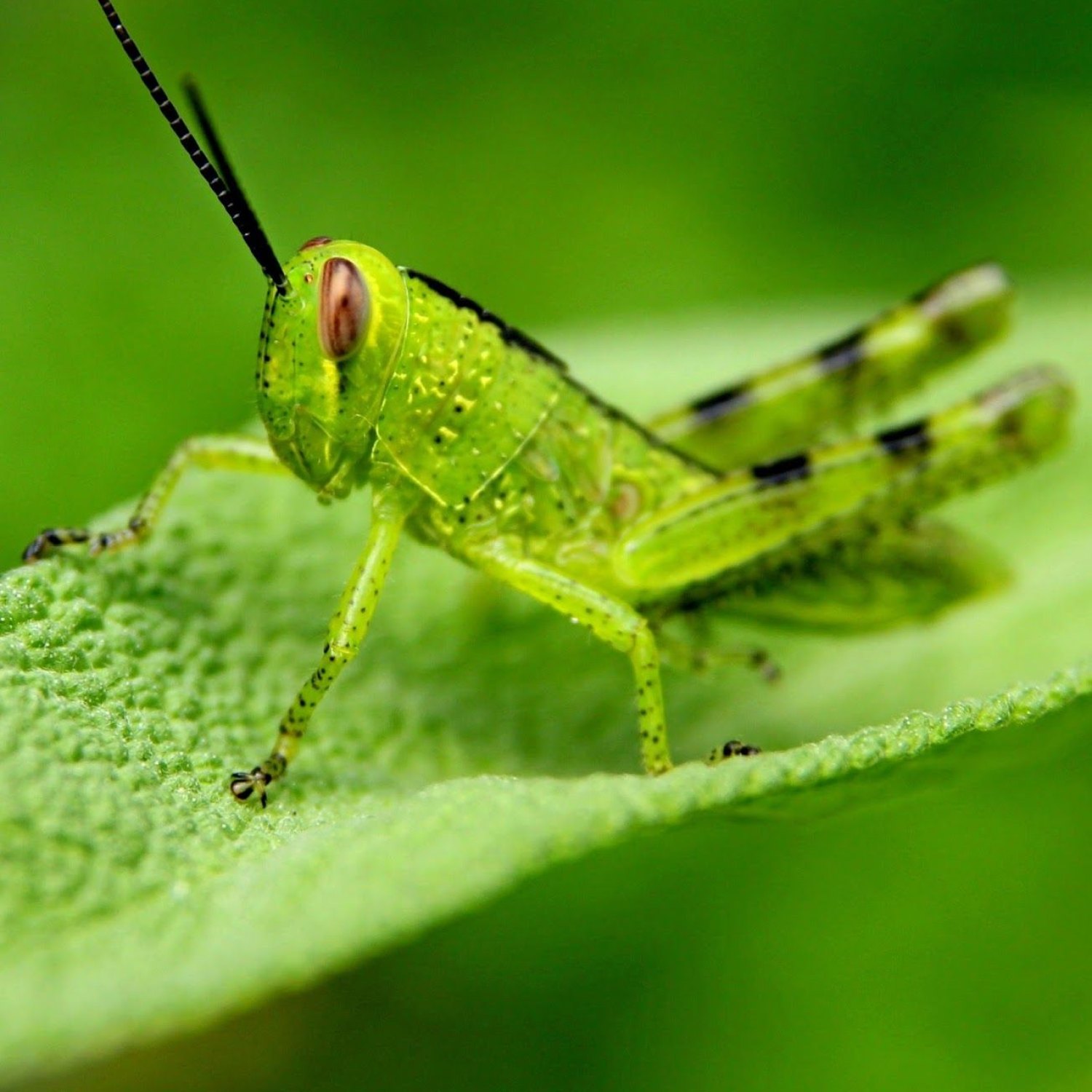
Grasshopper
0.6 to 4 inches (1.5 to 10 centimeters)
Grasshoppers are fascinating insects with a long and slender body, large hind legs, and vibrant colors. They range from 0.6 to 4 inches in length and can be found in various locations globally. These agile creatures are an essential part of the food chain, making them important to our ecosystem. Keep your eyes open for these tiny but mighty creatures in your backyard! #Grasshoppers #Animals #Nature
Animal Details Summary:
Common Name: Grasshopper
Kingdom: Animalia
Habitat: Grasslands, forests, meadows, and other open habitats
The Jumping Marvel: A Closer Look at the Grasshopper
Grasshoppers, we've all seen them jumping around in our gardens or fields, but have you ever stopped and truly appreciated this incredible insect? With their distinctive body shape, impressive jumping abilities, and important role in our ecosystem, there's more to these tiny creatures than meets the eye. From their scientific classification to unique features, let's dive deep into the world of grasshoppers.The Science behind the Hopper
Let's start with the basics – the scientific name of grasshoppers is Orthoptera. It comes from the Greek words "ortho" meaning straight and "pteron" meaning wing Grasshopper. This is a fitting description for these insects as their wings are straight and narrow, unlike other insects with folded or curved wings. Interestingly, this scientific name also refers to the fact that they are classified under the order Orthoptera, which includes locusts, crickets, and katydids.Grasshoppers belong to the kingdom Animalia, phylum Arthropoda, and class Insecta, making them a part of the diverse group of animals known as insects. Within the order Orthoptera, grasshoppers belong to the family Acrididae, which includes over 11,000 species! This family is further divided into subfamilies and tribes, making grasshoppers one of the largest families of insects.
Role in the Ecosystem
Grasshoppers may seem like just another insect, but they play a crucial role in many ecosystems around the world. As herbivorous insects, they mainly feed on plants and play a vital role in controlling plant growth. In grasslands, forests, and meadows, these insects help maintain the balance between plant growth and consumption. Without their natural pruning and grazing, plants could overgrow and disrupt the delicate ecosystem.Additionally, grasshoppers also serve as a food source for many predators, including birds, spiders, and other insects Grass Snake. They are an essential part of the food chain, and their absence could have a ripple effect on the entire ecosystem. In some cultures, grasshoppers are also consumed by humans as a protein-rich food source.
The Versatility of Habitat
One of the most impressive aspects of grasshoppers is their adaptability to different habitats. They are found worldwide, and each species has evolved to thrive in a specific environment. Generally, they prefer open habitats such as grasslands, forests, and meadows, but some species can also be found in urban areas.In areas with extreme weather conditions, such as deserts or tundras, grasshoppers have unique adaptations to survive. Some species have developed the ability to burrow underground to escape harsh temperatures, while others have a waxy outer layer to prevent dehydration in hot and dry climates. This versatility in habitat makes grasshoppers a resilient species, well-equipped to handle changing environments.
The Grasshopper Diet
As herbivores, grasshoppers have an insatiable appetite for plants. They can consume up to 50% of their body weight every day, making them a significant threat to crops and gardens. However, as mentioned earlier, they also serve an essential role in controlling plant growth, making them an essential part of the ecosystem.Grasshoppers have specialized mouthparts called mandibles, which they use to bite and chew on plants. They are not picky eaters and will happily consume a variety of plants, including leaves, flowers, and grasses. Some species even have a preference for certain types of plants, making them important indicators of the health of a specific environment.
Global Distribution and Origin
As mentioned earlier, grasshoppers have a worldwide distribution, with different species found on every continent except Antarctica. These insects have been around for over 300 million years, dating back to the Carboniferous period. While scientists believe that the earliest grasshoppers originated in North America, their precise country or location of origin is still unknown.Distinctive Features of Grasshoppers
Aside from their impressive jumping abilities and unique habitat adaptability, grasshoppers have several other distinguishing features. One of the first things you may notice about a grasshopper is its coloration. They come in a variety of earthy shades, with green and brown being the most common. These natural colors serve as camouflage, making it easier for them to hide from predators in their surroundings.Another notable feature of grasshoppers is their body shape. They have a long and slender body, making them well-suited for hopping and jumping. Their hind legs are significantly larger and stronger than their front legs, enabling them to jump long distances.
Grasshoppers also have two pairs of wings, with the front pair being tough and protective. The inner wings, known as the hind wings, are used for flying and are often brightly colored in males, while females have duller wings.
The Incredible Jumping Abilities
Grasshoppers are often praised for their incredible jumping abilities, which can reach up to 20 times their body length. So how do they do it? The secret lies in their hind legs, which are equipped with a complex system of musculature and tendons. When a grasshopper wants to jump, it contracts its muscles, causing the legs to store energy like a spring. Then, when it releases its muscles, the stored energy propels the insect forward, resulting in a powerful jump.One particular species, the American grasshopper, even holds the world record for the longest recorded jump by an insect, at an impressive 20 inches (50.8 centimeters).
The Birth of a Grasshopper
Grasshoppers have a fascinating life cycle, starting with the birth of a nymph. Female grasshoppers lay their eggs in the soil during fall or early spring, and the eggs can remain dormant for months before hatching. Once hatched, the nymphs look like miniature adults but without wings. They grow and molt several times before reaching adulthood, which can take anywhere from several weeks to several months, depending on the species.Once they reach adulthood, grasshoppers continue to molt and grow, but their metamorphosis is not as drastic as other insects like butterflies. They reach full maturity within a few weeks, and some species may even have multiple generations within one year.
The Grasshopper and Humans
As mentioned earlier, grasshoppers can be consumed by humans as a source of protein. In some cultures, they are considered a delicacy and are fried, dried, or incorporated into traditional dishes. However, in some areas, grasshoppers are seen as pests and are targeted with pesticides to protect crops and vegetation.Unfortunately, with the widespread use of pesticides and human activity causing habitat destruction, grasshopper populations are declining in some areas. This has a significant impact on the environment and the animals that rely on them as a food source. It's essential to strike a balance between protecting our crops and preserving the diversity of our natural ecosystems.
In Conclusion
The grasshopper may seem like a simple insect, but upon closer inspection, it's clear that these creatures are incredibly complex and vital to our world. From their impressive jumping abilities to their unique habitat adaptability, grasshoppers are truly a marvel of nature. So the next time you see a grasshopper hopping around, take a moment to appreciate their beauty and importance in our ecosystem.

Grasshopper
Animal Details Grasshopper - Scientific Name: Orthoptera
- Category: Animals G
- Scientific Name: Orthoptera
- Common Name: Grasshopper
- Kingdom: Animalia
- Phylum: Arthropoda
- Class: Insecta
- Order: Orthoptera
- Family: Various
- Habitat: Grasslands, forests, meadows, and other open habitats
- Feeding Method: Herbivorous
- Geographical Distribution: Worldwide
- Country of Origin: N/A
- Location: N/A
- Animal Coloration: Green, brown, and other earthy colors
- Body Shape: Long and slender body with large hind legs
- Length: 0.6 to 4 inches (1.5 to 10 centimeters)
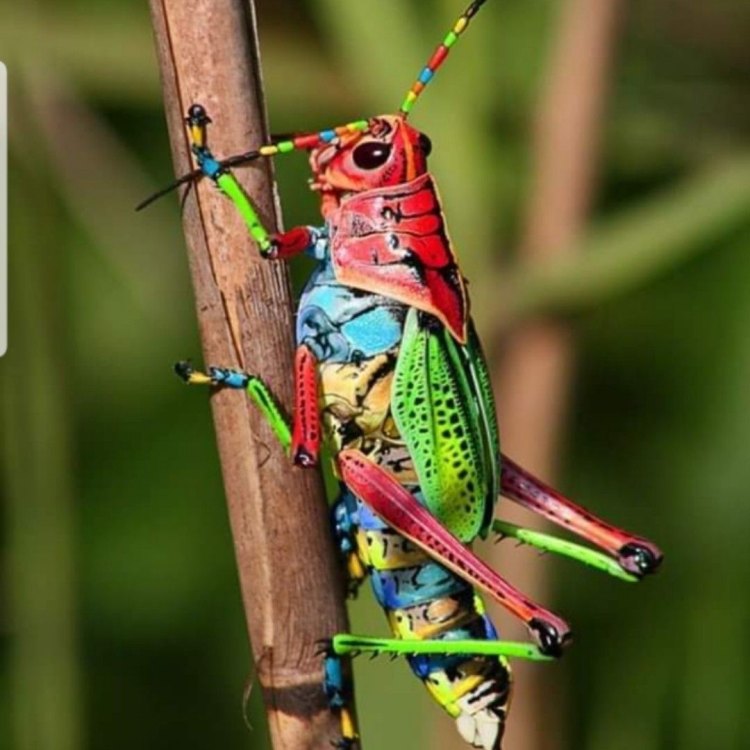
Grasshopper
- Adult Size: Varies depending on the species
- Average Lifespan: 1 to 2 months
- Reproduction: Sexual
- Reproductive Behavior: Males produce sounds or calls to attract females
- Sound or Call: Grasshoppers produce chirping sounds by rubbing their wings or legs together
- Migration Pattern: Some grasshopper species migrate seasonally
- Social Groups: Solitary, but may gather in large groups in certain circumstances
- Behavior: Active during the day, particularly in warm weather
- Threats: Predation, habitat loss, climate change
- Conservation Status: Not evaluated by the IUCN
- Impact on Ecosystem: Important prey for birds and other predators, some species can have significant agricultural impacts
- Human Use: Used as food in certain cultures, can be kept as pets
- Distinctive Features: Large hind legs for jumping, long antennae, chewing mouthparts
- Interesting Facts: Grasshoppers can jump up to 20 times their own body length
- Predator: Birds, reptiles, amphibians, spiders, and other insects
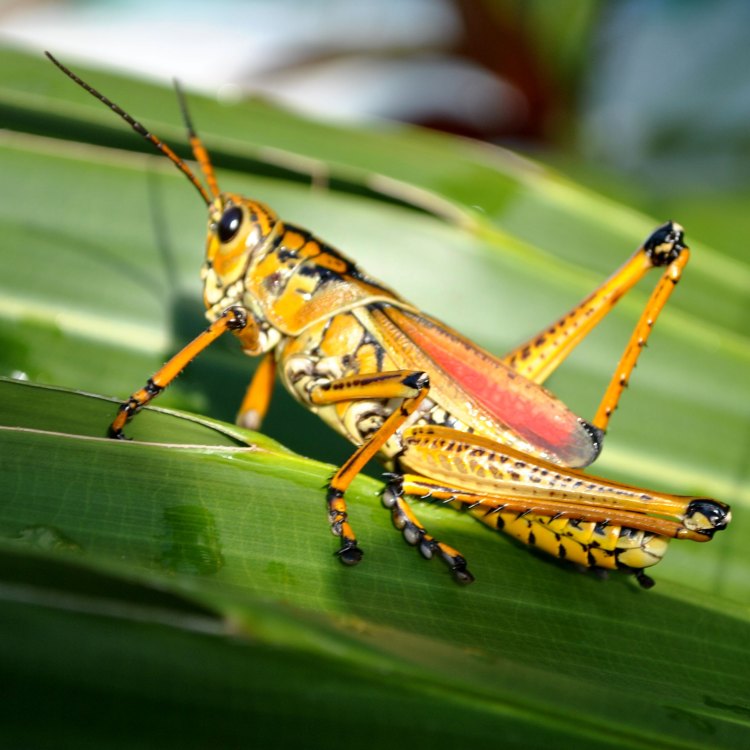
Orthoptera
The Story of the Grasshopper: A Fascinating Insect of Adaptability and Survival
The warm sun is shining, and the fields are buzzing with chirping sounds. As you walk through the grass, you may come across a small and curious insect - the grasshopper. With its long hind legs and large eyes, this fascinating creature is a prominent feature of many ecosystems around the world. But how much do we really know about these jumping insects? In this article, we will take a closer look at the unique features and behaviors of the grasshopper, as well as its impact on the environment and human culture PeaceOfAnimals.Com.An Incredible Adaptability
The grasshopper, belonging to the order Orthoptera, is a remarkable insect known for its incredible jumping abilities. But this is not the only feature that makes it stand out. Adult grasshoppers vary in size depending on the species, ranging from 1 to 7 centimeters in length. They are mostly found in grassy and open areas, as their bodies are well adapted for life on the ground. Their long hind legs allow them to jump and leap great distances, while their large eyes provide them with excellent vision.One of the most fascinating aspects of the grasshopper is its ability to adapt to different environments. They can thrive in a variety of habitats, from prairies to deserts, and even in urban areas. Some species are also able to change their body color to blend in with their surroundings, providing them with protection from predators. This adaptability has allowed the grasshopper to survive and thrive for millions of years Golden Trout.
A Short But Busy Life
Grasshoppers have a relatively short lifespan, with most species only living for 1 to 2 months. However, they make the most out of their time on earth, constantly on the move and engaging in various behaviors. They are active during the day, with their activity levels increasing in warm weather. This is why we often associate the sound of chirping grasshoppers with a sunny summer day.Being insects, grasshoppers undergo metamorphosis, starting their lives as eggs and then hatching into nymphs. As they grow and develop, they molt several times before reaching adulthood. Male grasshoppers are easily recognizable by their chirping sounds, which they produce to attract females for reproduction. This behavior is essential for the continuation of the species.
Impacts on Ecosystems
Despite their small size, grasshoppers play a vital role in various ecosystems. They serve as an important prey for birds, reptiles, amphibians, spiders, and other insects. Their diverse diet includes plants, small insects, and even other grasshoppers. As they feed, they also contribute to nutrient cycling and soil aeration, which benefits plants and other organisms.Moreover, some grasshopper species migrate seasonally, which can have a significant impact on the ecosystem. These migrations can affect the population levels of plants and other animals, as well as distribute nutrients and control pest populations. These movements also help balance the distribution of resources, ensuring the survival of different species and maintaining a healthy ecosystem.
Threats and Conservation Status
Unfortunately, like many other species, grasshoppers face numerous threats to their survival. The loss of their habitats due to human activities, such as urbanization and agriculture, is one of the primary threats. This loss of habitat can also affect their food sources, making it difficult for them to find sufficient nutrition.Climate change is also a significant concern for grasshoppers. As temperatures rise, some species may not be able to adapt and may experience population declines. This can have a ripple effect on the entire ecosystem, as grasshoppers are an essential part of the food chain.
Despite these threats, the conservation status of grasshoppers has not been evaluated by the International Union for Conservation of Nature (IUCN). This lack of data highlights the need for further research and understanding of the grasshopper's role in the environment.
The Human Connection
The use of grasshoppers by humans dates back centuries, with records of their consumption as food in certain cultures. In Central and South America, roasted grasshoppers are considered a delicacy and are still consumed today. In some regions of Asia and Africa, grasshoppers are also used in traditional medicine for their supposed healing properties.Apart from their use as food and medicine, grasshoppers are also kept as pets in some parts of the world. Their fascinating jumping abilities and unique features make them an intriguing choice for pet owners. However, it is crucial to obtain these insects from responsible and authorized sources, as removing them from their natural habitats can have detrimental effects on their populations.
A Curious and Versatile Creature
One cannot mention grasshoppers without acknowledging their distinctive features. Apart from their ability to jump great distances, they also have long antennae and chewing mouthparts. These features help them navigate their surroundings and obtain food. Additionally, their hind legs are adapted for jumping, with muscles that allow them to propel their bodies forward with incredible force.An interesting fact about grasshoppers is their ability to jump up to 20 times their own body length. This feat is made possible by a combination of their long and flexible hind legs, powerful muscles, and lightweight exoskeleton. This is a vital survival mechanism for grasshoppers as they can quickly escape from predators or jump onto a food source.
Predators of the Grasshopper
Despite their impressive jumping abilities, grasshoppers are not invincible. They have several predators in their natural habitats, including birds, reptiles, amphibians, spiders, and other insects. Frogs, toads, and lizards are among the main predators of grasshoppers, as they have great agility and can easily catch these insects.Birds, particularly sparrows, also prey on grasshoppers. Their sharp beaks and keen eyesight make it easy for them to spot and capture these insects. Insects such as praying mantises and dragonflies also pose a threat to grasshoppers, as they can catch them in mid-air with their strong front legs.
A Natural Symphony
If you have ever walked through a grassy field, you may have noticed the chirping sounds of grasshoppers. These sounds are produced not only for mating purposes but also as a defense mechanism. Grasshoppers produce chirping sounds by rubbing their wings or legs together, a process known as stridulation. Each species has a distinct sound, making it easier for them to recognize and attract potential mates.In some cultures, these sounds are seen as a natural symphony, with each species contributing to the overall melody. New research has even suggested that the sounds produced by some grasshoppers can act as environmental indicators, providing information about climatic conditions.
The Grasshopper: An Insect of Resilience and Adaptation
From its incredible jumping abilities to its unique chirping sounds, the grasshopper is a fascinating and versatile creature. Despite facing numerous threats, this insect continues to survive and thrive in various habitats. As we continue to learn more about the grasshopper's role in the environment, it is essential to work towards protecting and preserving this resilient and adaptable insect. So the next time you come across a grasshopper, take a moment to appreciate its beauty and significance in the natural world.

The Jumping Marvel: A Closer Look at the Grasshopper
Disclaimer: The content provided is for informational purposes only. We cannot guarantee the accuracy of the information on this page 100%. All information provided here may change without prior notice.




